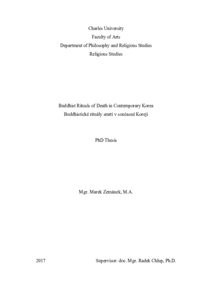Buddhist Rituals of Death in Contemporary Korea
Buddhistické rituály smrti v současné Koreji
dizertační práce (OBHÁJENO)

Zobrazit/
Trvalý odkaz
http://hdl.handle.net/20.500.11956/86790Identifikátory
SIS: 105038
Kolekce
- Kvalifikační práce [23740]
Autor
Vedoucí práce
Oponent práce
Löwensteinová, Miriam
Berounský, Daniel
Fakulta / součást
Filozofická fakulta
Obor
Religionistika
Katedra / ústav / klinika
Ústav filosofie a religionistiky
Datum obhajoby
28. 6. 2017
Nakladatel
Univerzita Karlova, Filozofická fakultaJazyk
Angličtina
Známka
Prospěl/a
Klíčová slova (česky)
korejský buddhismus, rituál, smrt, musok, ch'ŏndo chaeKlíčová slova (anglicky)
Korean Buddhism, death, ritual, musok, ch'ŏndo chaePráce se zabývá problematikou rituálů smrti v korejském buddhismu, stále vlivné a živé náboženské tradici v Korejské republice. Na metodologické rovině spojuje analýzu rituálního textu s terénním výzkumem. Předmluva a úvodní kapitola nastiňuje autorův zájem, vztah k tématu a základní cíle práce. Následně shrnuje teoretický rámec, zejm. teorie Hertze a van Gennepa, postup a problémy řešené při vytváření korpusu rituálních textů a popisuje kvalitativní výzkum mezi mnichy i laiky, jeho specifika a úskalí. V úvodu druhé kapitoly autor poukazuje na modulární charakter rituálů a s ním spojenou problematiku komplexnosti a rozmanitosti rituálu a navrhuje schéma dvou os, kde horizontální osa představuje jednotlivé moduly, stavební bloky ceremonií, a vertikální osa vyjadřuje rozmanitost rituálních konstituentů. V druhé části kapitoly se zabývá dvěma klíčovými konstituenty, zemřelým a rituálními aktéry. Třetí kapitola je stručným přehledem rituálního procesu od okamžiku smrti až po neohraničenou dobu po skončení čtyřiceti devítidenního období truchlení a zvýšené rituální aktivity. Současnou, konfucianismem a lidovým náboženstvím ovlivněnou praxi, porovnává s buddhistickými rituály v korejských dějinách, čímž ukazuje, že se v dnešním rituálu projevují určité ustálené buddhistické rituální vzorce či struktury...
The aim of the dissertation is to present the complex system of Buddhist rituals of death. Being the first lengthy study on the topic written outside Korea, this work introduces these rituals in the context of the rich Korean religious scene and indicates its connection to other religious and philosophical ideas present in the Sinitic cultural area. The dissertation is structured into five sections, each of which approaches the rituals from a different perspective. The "Introduction," presents the methodology, including the theoretical framework; textual research of ritual texts and fieldwork are the two key methodological approaches used to study the topic at hand. Chapter 2, "The Ritual Constituents," is an attempt to define an apparatus for analysis of the rituals. The two-axis scheme is an attempt to provide a tool, which will help us grasp not only the relative "richness" of the ritual but also its variability. Chapter 3, "The Structure and Typology of the Rituals," presents an overall analysis of the ritual process from the deathbed, to rebirth, and beyond. Its structure is based on contemporary rituals. I also use examples from Korean historical sources to demonstrate that certain types of rituals have been standard ritual activities throughout the history of Korean Buddhism. Chapter 4, "The...
